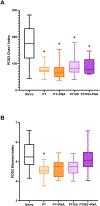Acute emergence of the intestinal pathobiome after postinjury pneumonia
- PMID: 38480488
- PMCID: PMC11199099
- DOI: 10.1097/TA.0000000000004300
Acute emergence of the intestinal pathobiome after postinjury pneumonia
Abstract
Background: Previous preclinical studies have demonstrated sex-specific alterations in the gut microbiome following traumatic injury or sepsis alone; however, the impact of host sex on dysbiosis in the setting of postinjury sepsis acutely is unknown. We hypothesized that multicompartmental injury with subsequent pneumonia would result in host sex-specific dysbiosis.
Methods: Male and proestrus female Sprague-Dawley rats (n = 8/group) were subjected to either multicompartmental trauma (PT) (lung contusion, hemorrhagic shock, cecectomy, bifemoral pseudofracture), PT plus 2-hour daily restraint stress (PT/RS), PT with postinjury day 1 Pseudomonas aeruginosa pneumonia (PT-PNA), PT/RS with pneumonia (PT/RS-PNA), or naive controls. Fecal microbiome was measured on days 0 and 2 using high-throughput 16S rRNA sequencing and Quantitative Insights Into Microbial Ecology 2 bioinformatics analyses. Microbial α-diversity was assessed using Chao1 (number of different unique species) and Shannon (species richness and evenness) indices. β-diversity was assessed using principal coordinate analysis. Significance was defined as p < 0.05.
Results: All groups had drastic declines in the Chao1 (α-diversity) index compared with naive controls ( p < 0.05). Groups PT-PNA and PT/RS-PNA resulted in different β-diversity arrays compared with uninfected counterparts (PT, PT/RS) ( p = 0.001). Postinjury sepsis cohorts showed a loss of commensal bacteria along with emergence of pathogenic bacteria, with blooms of Proteus in PT-PNA and Escherichia-Shigella group in PT/RS-PNA compared with other cohorts. At day 2, PT-PNA resulted in β-diversity, which was unique between males and females ( p = 0.004). Microbiome composition in PT-PNA males was dominated by Anaerostipes and Parasuterella , whereas females had increased Barnesiella and Oscillibacter . The PT/RS males had an abundance of Gastranaerophilales and Muribaculaceae .
Conclusion: Multicompartmental trauma complicated by sepsis significantly diminishes diversity and alters microbial composition toward a severely dysbiotic state early after injury, which varies between males and females. These findings highlight the role of sex in postinjury sepsis and the pathobiome, which may influence outcomes after severe trauma and sepsis.
Copyright © 2024 Wolters Kluwer Health, Inc. All rights reserved.
Conflict of interest statement
The authors declare no conflicts of interest. This research was supported by the National Institutes of Health. AMM was supported by NIH NIGMS R01 GM105893. JAM, LSK, and SLK were supported by postgraduate training grant NIH NIGMS T32 GM-008721 in burns, trauma, and perioperative injury. GSG was supported by postgraduate training grant NIH NHLBI T32 HL-160491 interdisciplinary training for vascular surgeon scientists. All conflicts of interest disclosure forms for the
Figures






Similar articles
-
Multicompartmental traumatic injury induces sex-specific alterations in the gut microbiome.J Trauma Acute Care Surg. 2023 Jul 1;95(1):30-38. doi: 10.1097/TA.0000000000003939. Epub 2023 Mar 6. J Trauma Acute Care Surg. 2023. PMID: 36872509 Free PMC article.
-
POSTINJURY PNEUMONIA INDUCES A UNIQUE BLOOD MICROBIOME SIGNATURE.Shock. 2024 Dec 1;62(6):762-771. doi: 10.1097/SHK.0000000000002428. Epub 2024 Aug 8. Shock. 2024. PMID: 39178199
-
Multicompartmental traumatic injury and the microbiome: Shift to a pathobiome.J Trauma Acute Care Surg. 2023 Jan 1;94(1):15-22. doi: 10.1097/TA.0000000000003803. Epub 2022 Oct 7. J Trauma Acute Care Surg. 2023. PMID: 36203239 Free PMC article.
-
Systemic pharmacological treatments for chronic plaque psoriasis: a network meta-analysis.Cochrane Database Syst Rev. 2021 Apr 19;4(4):CD011535. doi: 10.1002/14651858.CD011535.pub4. Cochrane Database Syst Rev. 2021. Update in: Cochrane Database Syst Rev. 2022 May 23;5:CD011535. doi: 10.1002/14651858.CD011535.pub5. PMID: 33871055 Free PMC article. Updated.
-
Systemic pharmacological treatments for chronic plaque psoriasis: a network meta-analysis.Cochrane Database Syst Rev. 2017 Dec 22;12(12):CD011535. doi: 10.1002/14651858.CD011535.pub2. Cochrane Database Syst Rev. 2017. Update in: Cochrane Database Syst Rev. 2020 Jan 9;1:CD011535. doi: 10.1002/14651858.CD011535.pub3. PMID: 29271481 Free PMC article. Updated.
Cited by
-
Gut microbiota constituents may affect hypertrophic scarring risk through interaction with specific immune cells in a two-step, two-sample Mendelian randomization study.Sci Rep. 2025 Jul 1;15(1):20656. doi: 10.1038/s41598-025-07455-y. Sci Rep. 2025. PMID: 40596527 Free PMC article.
References
-
- Haak BW, Wiersinga WJ. The role of the gut microbiota in sepsis. Lancet Gastroenterol Hepatol. 2017;2(2):135–43. - PubMed
MeSH terms
Substances
Grants and funding
LinkOut - more resources
Full Text Sources

